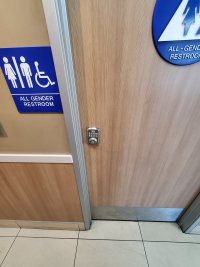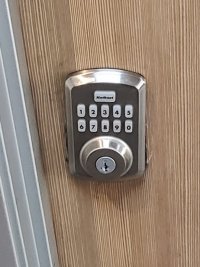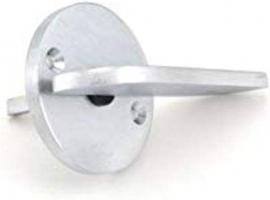-
Welcome to The Building Code Forum
Your premier resource for building code knowledge.
This forum remains free to the public thanks to the generous support of our Sawhorse Members and Corporate Sponsors. Their contributions help keep this community thriving and accessible.
Want enhanced access to expert discussions and exclusive features? Learn more about the benefits here.
Ready to upgrade? Log in and upgrade now.
You are using an out of date browser. It may not display this or other websites correctly.
You should upgrade or use an alternative browser.
You should upgrade or use an alternative browser.
Code required.. to get in
- Thread starter ICE
- Start date
Yankee Chronicler
REGISTERED
Is it locked at all times, or only when occupied?
It doesn't appear to violate 11B-309 or 11B-603, so to someone from the other side of the country it looks okay from here.
[EDIT] Correction. I just looked up Kwikset's web site. This thing appears to be their Series 250 PowerBolt keypad lock. Unless there's something special about the one Burger King uses, the standard Series 250 keypad lock is a deadbolt type lock, not a latcbolt type -- and operation from the interior is by thumbturn. Which WOULD be a violation of 11B-309 for operable parts (no pinching, tight grasping, or twisting of the wrist).
It doesn't appear to violate 11B-309 or 11B-603, so to someone from the other side of the country it looks okay from here.
[EDIT] Correction. I just looked up Kwikset's web site. This thing appears to be their Series 250 PowerBolt keypad lock. Unless there's something special about the one Burger King uses, the standard Series 250 keypad lock is a deadbolt type lock, not a latcbolt type -- and operation from the interior is by thumbturn. Which WOULD be a violation of 11B-309 for operable parts (no pinching, tight grasping, or twisting of the wrist).
Last edited:
Yikes
SAWHORSE
YC, I have the Schlage equivalent of this at my house, and am able to unlatch it with a closed fist. Not sure if the Kwikset can operate similarly.
Regardless, you are correct regarding the hardware that is visible in the photo in post #1.
Regardless, you are correct regarding the hardware that is visible in the photo in post #1.
Last edited:
fatboy
Administrator
I also have seen and used interior "thumb" latches with my fist or elbow, no "pinching" to it, unless you can, and want to!!
Yankee Chronicler
REGISTERED
Does the title of this thread mean that this door is always locked, and that a patron has to find an employee and request the code before they can use the restroom? If that's the case, I don't think it's acceptable. Decades ago, the Access Board ruled that the practice of requiring a key to operate platform lifts was not allowed under the ADA, because it required the person who needed the lift to traverse the accessible route to find the person who had the key and for that person to then respond to the location and to unlock the lift. I view this in the same way. If someone needs to use the restroom NOW, they shouldn't have to seek out an employee and hope the employee they find knows and remembers the combination to the lock.
I don't think this arrangement would be allowed under the IPC, but I know that California uses the UPC and I don't have access to to that to see what (if anything) it says about patron access to toilet facilities in restaurants. I did find a potentially applicable section in CBC 11B though:
11B-213.2.1 "Doors to unisex (single-user or family) toilet rooms and unisex (single-user or family) bathing rooms shall have privacy latches." Do these pushbutton locks offer a privacy lock function? The keyway on the outside certainly isn't consistent with a privacy lock function.
I don't think this arrangement would be allowed under the IPC, but I know that California uses the UPC and I don't have access to to that to see what (if anything) it says about patron access to toilet facilities in restaurants. I did find a potentially applicable section in CBC 11B though:
11B-213.2.1 "Doors to unisex (single-user or family) toilet rooms and unisex (single-user or family) bathing rooms shall have privacy latches." Do these pushbutton locks offer a privacy lock function? The keyway on the outside certainly isn't consistent with a privacy lock function.
Yikes
SAWHORSE
The issue with the wheelchair lift was likely one of equivalent access facilitation.Does the title of this thread mean that this door is always locked, and that a patron has to find an employee and request the code before they can use the restroom? If that's the case, I don't think it's acceptable. Decades ago, the Access Board ruled that the practice of requiring a key to operate platform lifts was not allowed under the ADA, because it required the person who needed the lift to traverse the accessible route to find the person who had the key and for that person to then respond to the location and to unlock the lift. I view this in the same way. If someone needs to use the restroom NOW, they shouldn't have to seek out an employee and hope the employee they find knows and remembers the combination to the lock.
If a pedestrian can independently access an upper floor by ascending a set of stairs, but a person in a wheelchair must first track down a property manager to retrieve a key to use the lift, then the case could be made that they are not being treated in an equivalent manager.
In the case of the Burger King combination lock, everyone (regardless of ability / disability) gets treated equally - - they all have to ask at the front counter for the lock combination.
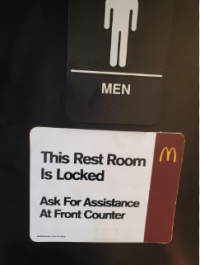
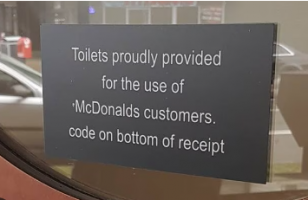
FWIW, the use of a combo lock makes it MORE likely that the restroom will be available NOW when someone needs it for toilet use. With our dual public health issues of homelessness and substance abuse in California, many retail food facilities have had problems with the public wandering in to a single occupancy restroom, locking the door, and staying in there for several hours to get high and/or get sleep. It's been almost 10 years since I saw my first "restroom time limit 30 minutes" sign at a McDonalds in Fresno.
bill1952
SAWHORSE
Accessibility is based on discrimination. If to go up a level, I don't need a key for the stairs, so shouldn't need one for a lift, else discrimination. If everyone needs a key or pin for a restroom door, no discrimination.
mark handler
SAWHORSE
tmurray
SAWHORSE
Is the keypad itself accessible? What are everyone's thoughts on that?
Yankee Chronicler
REGISTERED
Is the keypad itself accessible? What are everyone's thoughts on that?
As an accessibility consultant I don't like it, but the code requirement is "no pinching, tight grasping, or twisting of the wrist," so it doesn't appear to be disallowed by code.
Yankee Chronicler
REGISTERED
Accessibility is based on discrimination. If to go up a level, I don't need a key for the stairs, so shouldn't need one for a lift, else discrimination. If everyone needs a key or pin for a restroom door, no discrimination.
Agreed.
bill1952
SAWHORSE
There has been some development in the current revision cycle of A117.1 (which is now properly known as ICC A117.1, not ANSI) on "controls". I have not personally followed it but might change the keypad answer. (Albeit, sometime after the 2027 IBC is adopted.)
Do you think this keypad is less accessible than a gas pump, ATM, or point of sale device, all used by people with disabilities?
Do you think this keypad is less accessible than a gas pump, ATM, or point of sale device, all used by people with disabilities?
arwat23
SAWHORSE
I second this. I hate it personally, but I can't find anything in CBC that specifically prevents this from happening. The only thing I can think of that might disallow this is the requirement for a "privacy latch" on restroom doors (11B-213.2.1). Admittedly, this is a stretch, but I have seen a local AHJ prevent a similar setup because the lock did not engage automatically like a latch typically does. That may just be up to interpretation though.As an accessibility consultant I don't like it, but the code requirement is "no pinching, tight grasping, or twisting of the wrist," so it doesn't appear to be disallowed by code.
jar546
CBO
This is an all too common and somewhat normal situation depending on what part of town you are in and sometimes that doesn't matter. I've seen this in ritzy parts of town that had a college campus. What is the difference between this and a gas station attendant giving you an outside bathroom key attached to an 8' CMU?
tbz
SAWHORSE
I ran into one of these for the first time in a Gas & Go type store back in 2022 driving to KY for the hearings.
Above the digital lock was another privacy bolt with the standard slot key.
The digital lock used a latch not a bolt, thus latching locked when the door closed, I have also seen the dead bolt styles and lock when the door closes and that could be considered auto-latching.
What I found a bit taxing was for privacy having to activate a secondary device, but I see no conflict as all are treated the same to get access.
Above the digital lock was another privacy bolt with the standard slot key.
The digital lock used a latch not a bolt, thus latching locked when the door closed, I have also seen the dead bolt styles and lock when the door closes and that could be considered auto-latching.
What I found a bit taxing was for privacy having to activate a secondary device, but I see no conflict as all are treated the same to get access.
Mr. Inspector
SAWHORSE
Most of the gas stations that I have finialed take the restroom signs down and put a lock on the doors soon after they get the C. O.
I see no conflict as all are treated the same to not get access.
I see no conflict as all are treated the same to not get access.
mark handler
SAWHORSE
IMPO, yes, it is accessible.Is the keypad itself accessible? What are everyone's thoughts on that?
Just like keypads on a phone or elevator.
Yikes
SAWHORSE
https://www.access-board.gov/ada/guides/chapter-3-operable-parts/What about the person with the claw or no hands, how does that work?
Excerpts:
Latches and Locks
Latches and locks with small parts that must be manipulated can be difficult to use and will not comply if pinching is necessary. However, non-fixed portions of locks and other operable parts, such as keys and access cards, are not required to comply (but those that do not require pinching or turning provide better access). Hardware that does not require simultaneous actions are better, but some types, such as handles with thumb latches are acceptable.
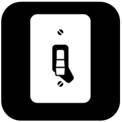
Controls and Switches
Dials and other controls that can be turned with the fingers but not the full hand can be used if they do not require twisting of the wrist or pinching. Flip switches and similar controls are acceptable, though push plate types can provide easier access.
Must operable parts be usable with a closed fist?
Closed-fist operation is a good performance test but is not required by the standards. Many types of operable parts, such as pull handles, satisfy the requirements even though they may not be operable with a closed fist.
Are turn-key locks prohibited by the standards?
Key locks or key cards are not prohibited by the standards which apply only to the fixed portions of operable parts. Similarly, items dispensed by ATMs and fare machines, such as receipts, cash, fare cards, and vending machine products are not covered by the standards.
my250r11
REGISTERED
The only thing that I can think of might be that it doesn't have the occupancy indicator.
mark handler
SAWHORSE
Which is also useless to a blind personThe only thing that I can think of might be that it doesn't have the occupancy indicator.
Yikes
SAWHORSE
I can understand a pushbutton lock may also need braille markings to comply with ADA.
But in terms of it making an actual difference in real-world usefulness, let's face it: a person who is completely blind is already going to follow sound to the front counter and ask for assistance to get into the bathroom, rather than wander around the restaurant until they find some tactile sign on a wall somewhere.
I have a friend who is now 100% blind. An increasing obstacle in recent years is not pushbuttons without braille: It is the lack of pushbuttons altogether, as more public interactions involve touch screens, or simply rely on apps on smart phones that have no buttons at all.
But in terms of it making an actual difference in real-world usefulness, let's face it: a person who is completely blind is already going to follow sound to the front counter and ask for assistance to get into the bathroom, rather than wander around the restaurant until they find some tactile sign on a wall somewhere.
I have a friend who is now 100% blind. An increasing obstacle in recent years is not pushbuttons without braille: It is the lack of pushbuttons altogether, as more public interactions involve touch screens, or simply rely on apps on smart phones that have no buttons at all.

